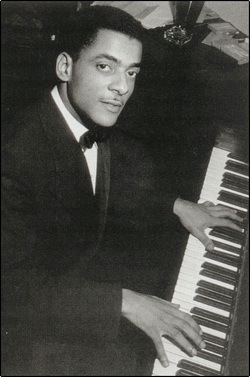 BORN 1912, DIED 1986 MUSICAL SELECTION: "Blues in C Sharp Minor", "My First Impression of You" One of the most urbane and accomplished pianist/leaders to come to prominence in the 1930's, Wilson was born in Austin, Texas, but grew up in Tuskegee, Alabama, where his father was English master and his mother librarian at Tuskegee University. Young Theodore learned violin and piano as a youth, discovering jazz from 78rpm records while he was studying for a music major at Talladega College. After a move to Detroit in 1929 Wilson began playing with local bands, including Speed Webb, for whom he made many arrangements, staying until 1931, when he moved via Toledo to Chicago, initially working with Erskine Tate before also playing with Louis Armstrong and Jimmie Noone. Wilson's arrival in New York in 1933 to play with Benn Carter presaged the beginning of his larger reputation. Recording with the Chocolate Dandies for John Hammond (who had arranged his transfer from Chicago), Wilson was quickly appreciated among New York musicians for his rock-steady left hand, his harmonic sophistication, and his immaculate righ-hand technique. He was also an inspired arranger, whether for small or large groups, and he was the perfect musical coordinator for the decade-long series of recordings undertaken by Brunswick and featuring assorted personnel, often with singer Billie Holiday as the focal point. These recordings, especially those featuring Holiday in tandem with Lester Youn, have justly become regarded as some of the crown jewels of jazz recording. By 1935 Wilson had been inducted into the Benny Goodman setup, initially as part of his Trio (one of the first racially mixed groups of the swing era), recording and touring with the leader as a separate musical unit to his big hand. Wilson's superb left hand, providing accurate rhythmic and harmonic support, knitted the group's efforts together while his righ-hand counterpoint added the dimension of musical converstion which led Goodman's group to be termed the first exponents of "chamber jazz." In 1936 Lionel Hampton's arrival made it a quartet and one of the most popular small groups in jazz history. Wilson left in 1939 to form his own short-lived big band. After its demise in 1940 he formed a sextet, which appeared regularly at Cafe' Society in New York and recorded for a number of labels, especially Musicraft, where he led his own sessions and arranged dates featuring Maxine Sullivan and, from 1946 onward, Sarah Vaughan. By the mid-1940s Wilson was reappearing with Goodman's small groups for short stints, but the rest of the decade was largely taken up with teaching and broadcasting work. Wilson spent most of the latter part of his career involved in teaching and in various music capacities for the broadcaster CBS, interspering this with appearances at major festivals with hand-picked groups (he was with one such band at the 1957 Newport Jazz Festival) or brief reunions with Benny Goodman. The original quartet made a last record together in 1963 and played occasional concerts. Wilson continued to make records up to the time of his death.
0 Comments
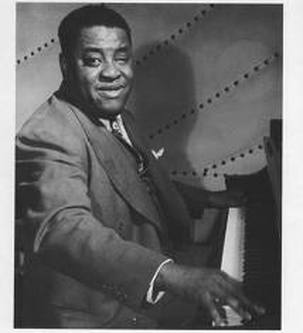 BORN 1910, DIED 1956 MUSICAL SELECTION: "Tiger Rag" For many years regarded as a nonpareil jazz pianist in terms of technique and harmonic imagination, more than four decades after his death Tatum still has few if any peers in these areas. Born in Toledo, Ohio, and from birth suffering from blindness in one and severe limitations in the other, Tatum was drawn to music from boyhood, taking up both violin and piano. By the time he was 13 the violin had been jettisoned in favor of piano, with Tatum receiving some formal training while at Toledo School of Music. He mastered the Braille method of reading music as well as using powerful glasses to read ordinary manuscripts, but the majority of his learning was done after leaving school. Furing the 1920s he learned from records, piano rolls and other means, perfecting the most effortless stride technique ever heard as well as embarking on his lifetime fascination with ever more sophisticated chord substitutions and elaborate rearrangement of popular tunes, overlaid by a richly baroque right-hand technique and a uniquely flexible approach to metric time. Tatum was already known by word of mouth before his arrival in New York in 1932, but his debut there as accompanist to Adelaide Hall, followed by an engagement as a solo at the Onyx club and his first recordings (including the legendary "Tiger Rag" at what was commonly acknowledged by other pianists to be an "impossible" tempo) caused astonishment. Tatum was quickly and widely acknowledged as so far ahead of the pack (including his original ido, Fats Waller) as to be in a league of his own. By the mid-1930s he was internationally known as a true phenomenon on his instrument, his later piano-guitar-bass trio with Tiny Grimes a model for hundreds of other piano trios to follow in its level of musical interplay. Tatum's fame breached parochial jazz borders, bringing musicians such as Horowitz and Toscanini to Harlem clubs after Carnegie Hall performances to witness his genius. His innovations, often skirted by pianists overawed by his technique, were most successfully incorporated by sax players, from Coleman Hawkins onward, who were able to transfer Tatum's quicksilver harmonic thinking to their melody instruments. Tatum's popularity took a tumble in the late 1940s as jazz fashions changed and other, more startling and energetic styles came to the fore. However, in the 1950s he signed to Norman Granz's label and began in 1953 on a project to record one of the taped over the next three years, is available on CD on the Pablo label: the solo performances alone take up seven CDs, while the group performances range from a trio session with bass and drums to separte dates with Roy Eldridge, Ben Webster, Benny Carter, Lionel Hampton, Buddy DeFrance, and Harry Edison. Tatum was often criticized for being an overwhelming accompanist: here he shows that, with player of commensurate stature, he complements busily but always appositely. With the solo performances, he so thoroughly rethought the standards he played that they became vessels for his own musical messages. Tatum died in 1956 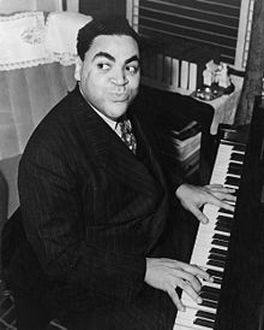 Fats Waller: BORN 1903; DIED 1943 Musical Selection: "Honeysuckle Rose", "Ain't Misbehavin' ", "Jitterbug Waltz" Thomas "Fats" Waller was not only one of the greatest stride pianists in jazz and an inspried small-group leader, but was also a world-class tunesmith, an equable and occasinally moving singer, and one of the most charismatic personalities to emerge in the music-entertainment business between the wars. Waller was born in New York City into a Baptist lay preacher's family; the young Fats played organ at this father's services and was given a thorough training at the keyboard by private teachers. By his mid-teens Fats was working as a professional in the local Harlem theaters. Wall's mother died in 1920 and he moved in with family friends; through them he James P. Johnson, who gave him a gilt-edged introduction into the world of Harlem stride piano. During the 1920's he began recording for Okeh as an accompanying most of the great acts appearing in New York cabaret at the time, including Bessie Smith. Waller benefited from association with Okeh's Clarence Williams, having some of his early compositions such as "Squeeze Me" published in 1923. By the late 1920s Waller had begun regularly appearing on local radio as a pianist and singer and had also met up with lyricist Andy Razaf. Together they began writing for various New York theater shows, including Keep Shufflin' (1928) and Hot Chocolates (1929). Songs such as "Honeysuckle Rose," "Ain't Misbehavin'," and "Black and Blue" made their debut in such productions before the end of the decade. During this time Waller began his association with the Victor record company, one which would survive until his death; some of this earliest sides for Victor were with Fats Waller's Buddies. He would record a varied program of music for Victor in the next few years, including solo piano pieces and duets such as "Handful of Keys" and "Smashing Thirds." Waller began traveling widely in ther early 1930s as well as assiduously making radio broadcasts, while playing in a number of different bands. He reached Europe for the first time in 1932, but the most significant musical development was the formation in 1934 of Fats Waller and his Rhythm, a band of varying size (but usally a sextet) most regularly featuring trumpeter Herman Autry, saxophonist Gene Sedric, and guitarist Al Casey. This band became his primary musical vehicle and he made literally hundreds of records for RCA Victor with them. These ranged from the low satire of "Big Chief De Sota" to the slapstick of "The Joint Is Jumpin'" to the melancholy of "My Very Good Friend The Milkman" to the gentle brilliance of "Jitterbug Waltz." Furing the 1930s Waller rose steadily in public profile to become one of the most well-known entertainers on radio and a constant presence in the charts. He toured constantly, sometimes sticking on the West Coast for a time, or in Chicago, but always using New York as his base. By mid-decade he was hearing the siren call of Hollywood, appearing in films until 1938 when he was one of the stars in Stormy Weather, with Lena Horne. Waller died in that winter on the trans-American railway en route to New York from a long engagement in Los Angeles, succumbing to pneumonia after registering symptoms prior to his trip. Waller is remembered for his ready burlesquing wit, but he had higher aspirations: in London in 1938 he recorded his London Suite, a set of six conceivable he would have produced considerably more such instrumental compositions. 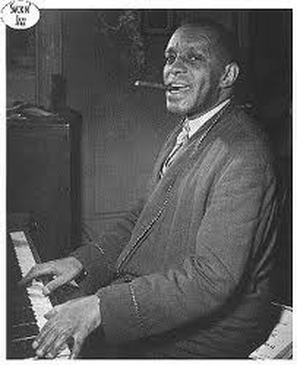 Willie “The Lion” Smith: Born 1897; Died 1973 Musical Selection: “Crazy Blues” Smith was born with the considerable name of William Henry Berthol Bonaparte Bertholoff, coming from a mixed-race marriage, Black and Jewish, but with his father dying when Willie was just four, and his mother’s subsequent marriage, the young Bertholoff later took on his stepfather’s surname. Smith was born in Goshen, New York, but grew up in Newark, New Jersey, learning piano from his mother, who was a church player. Smith’s main musical education was, by his own account, somewhat haphazard, but he was a quick learner and by 1914 he’d made his professional debut. Smith was soon plunged into the hectic and informal music world of Harlem, learning the emergent ragtime strain peculiar to the Eastern Seaboard, which, combined with elements of the gospel piano style and the urge to improvise on dance forms, would soon evolve into what would later be termed “stride.” He also learned the essential style accessories for the stride pianist, from his hat and cane (often accompanied by the biggest cigar available) to the braggadocio speech styles and flamboyant keyboard techniques, all of which would also be developed into a personal identifying trait by pianists such as Luckey Roberts, James P. Johnson, and Fats Waller, and which were very evident in the attitude evinced by New Orleans keyboard man Jelly Roll Morton, whom Smith often saw playing in New York prior to World War I. In late 1916 Smith volunteered for active service in WWI, after a training period being shipped off to the Western Front in summer 1917. Trained in artillery, he proved highly capable and was promoted to the rank of sergeant; he also claimed to have picked up his nickname, “The Lion,” there, bestowed on him by an officer inspecting the front, who was told of his expertise with large-bore artillery and his unusual stamina. Smith made sure the nickname struck. Having left the military in 1919, Smith returned to his old ways in Harlem, fast becoming one of the standouts in the emergent stride school, striking up friendships during the 1920s with the likes of Fats Waller and, especially, Duke Ellington. Smith began appearing on records (he was the accompanist to Mamie Smith on her trend-setting “Crazy Blues” of 1920) and ran his own small group at Harlem’s Leroy’s as well as, later one, the Onyx Club, Pod’s, and, finally, Jerry’s. Smith was a legend among fellow professionals but largely unknown to the general public until he began recording a series of piano solos for Decca in 1935. The striking individualism of these brought him a ready audience on both sides of the Atlantic, which he began to exploit after World War II through regular tours, even reaching North Africa in 1949-50. After that Smith was a regular part of the jazz and entertainment scene, his compelling character and stylized mode of dress making him instantly recognizable. During the 1960s he began to feel the need to document his life and the music he had grown up with: in 1965 he produced (with George hoefer) his autobiography, Music On My Mind, while for RCA in 1969 he recorded The Memoirs of Willie “The Lion” Smith, a two-disc LP set of his talking and playing. Smith died in 1973 an honored and feted man in the US and Europe. 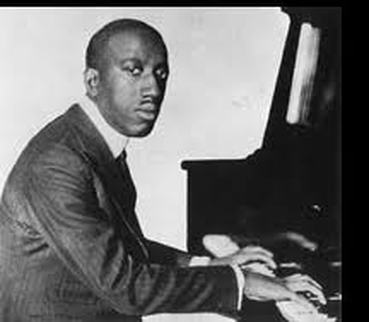 James P. Johnson: Born 1894; Died 1955. Musical Selection: “Yamacraw”, “Symphony Harlem”. Pianist-composer Johnson was born in New Brunswick, New Jersey, learning music from his mother. He moved with his family to New York in 1908, making a regular living at music before the end of the decade. Johnson eagerly took in all the music then thriving in New York, including ragtime, classical, and blues, and was serving up his version of all this to clients at various mid-town New York dives in the years prior to World War I, cutting his first cylinder rolls in 1916. Equally adept at theater music, Johnson traveled after the war to England with the show, Plantation Days, then on his return began to establish a reputation as a first-rate composer of show tunes, completing the score for the hit show Runnin’ Wild in 1923. By this time his driving piano style had matured into the stride left-hand figures for which he and other New York pianists of this time were to become world famous. Johnson, however, was more than just a pianist and songsmith, for during the 1920s and 1930s he consistently completed larger-scale, through-composed works, such as Yamacraw and Symphony Harlem, many of which were premiered in New York but most of which failed to find an audience: at this time, a black writing serious music simply had no niche to aim for. Undeterred, Johnson continued to compose, writing operatic works as well as, in 1938, completing a symphonic treatment of, “St Louis Blues.” For the rest of his career Johnson continued to write ambitious works and to play with a range of groups in and around New York, establishing himself undeniably as a significant figure in the jazz scene; he also stayed involved in revues and musicals, writing the music for 1949’s Sugar Hill; unfortunately, a stroke in 1951 rendered him incapable of actively pursuing his career any further. He died four years later. 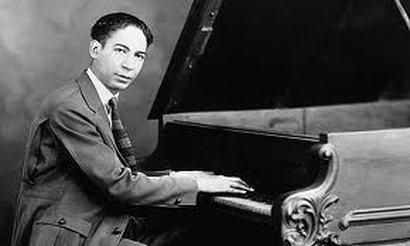 Jelly Roll Morton: Born 1890; Died 1941. Musical Selection: “King Porter”, “Jungle Blues”, “Black Bottom Stomp” For many years there was confusion over Morton’s date of birth: 1889 on his death certificate while other commentators pushed for 1885. The precise facts were established by Lawrence Gushee. He also found that Morton, born Ferdinand LaMenthe (the family name was LaMothe and he was baptized Lemott) in New Orleans, took the name Morton from a stepfather (who’s name was actually Mouton!) Morton started out on guitar as a boy before switching to piano in early adolescence. He claims to have been playing Storyville bordellos in 1902, though a date closer to the middle of the decade is more realistic; here he met and learned much from pianist Tony Jackson before moving on to other parts of Louisiana and Mississippi. Between 1906 and 1908 he traveled from Florida to California as well as Chicago, St Louis, and Houston, making money as a hustler, pool shark, part-time pimp, and all-round con man as well as learning much from the pianists he encountered, including the legendary “Jack The Bear.” In 1909 he worked in a Memphis theater, then joined a vaudeville team eventually making it to New York. Morton spent time in Chicago, running his own band in 1914-15, then pushed on to LA, where he met Anita Gonzales, later his wife, and more than once made it as far as Mexico. In 1923 Morton moved to Chicago, attracted by a booming music business there and the chance of recordings and piano rolls. That year he debuted on both recording media, also finding work with the Melrose publishing company and running his sometime band, the Rid Hot Peppers. In 1926 Morton began making the series of 78s for the Victor Company, which were to seal his jazz reputation. These were with his studio band, the sometimes septet/octet, the Red Hot Peppers, a band often featuring clarinetist Omer Simeon, trumpeter George Mitchell and trombonist Kid Ory. The style was New Orleans, but very much Morton’s own idea of New Orleans: in fact, his arrangements, allied to his humor and compositions, made for a vivid portrayal of the hybrid form of jazz. Pieces like “The Pearls,” “King Porter,” “Jungle Blues,” “Black Bottom Stomp,” “Dead Man Blues,” “Sidewalk Blues,” and many more all testify to his unique abilities. Compared with contemporaneous dance arrangements and tunes in 1926-28, Morton was streets ahead. Unfortunately, he alienated many people who could have helped, including the MCA booking agency. A Move to New York in 1928 presaged his eclipse. Morton wanted no part of the emerging big-band movement. In 1930 his Victor contract was not renewed. Down on his luck he made one Wingy Manone session in 1934 before moving to Washington, DC, once more leaving music for a period. Working as a pianist in a lowlife Washington club, Morton was approached by folklorist Alan Lomax to make a series of recordings for the Library of Congress in late summer 1938. The resulting records are one of the greatest first-hand archives of New Orleans testimony in existence. In between sessions, however, he was stabbed in a brawl at his club, triggering a round of ill health. A move back to New York in 1938 and radio appearances in the Big Apple let to Morton recording with Sidney Bechet and Albert Nichoas, making a fine session for Bluebird. Morton mad further records for General, piano solos, and group recordings, which show him to be in complete command of his abilities. If he had lived, he would undoubtedly have become a focal point for the 1940s revivalist. His deteriorating health was exacerbated by a cross-country winter drive 1940-41, and by the summer of 1941 Morton was dead. |
Jazz LegendsA blog on the great legends in Jazz. Information via "The Encyclopedia of Jazz and Blues". Archives
December 2017
Categories |
 RSS Feed
RSS Feed

